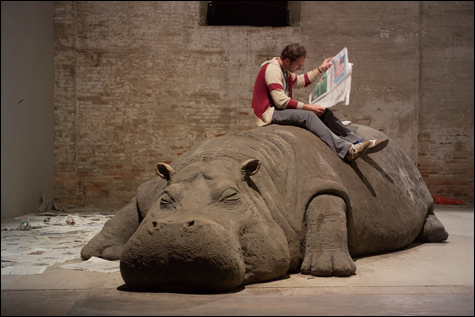
HOPE HIPPO: Jennifer Allora and Guillermo Calzadilla’s clever stunts provide some of the better
moments in Ice Cream. |
The folks at Phaidon Press proclaim that the 100 emerging international artists surveyed in their new book Ice Cream “will be the stars of tomorrow.” It’s depressing enough to see this round-up of dull, dour uptight art as a snapshot (and, to be fair, a pretty accurate one) of what’s young and hot in the upper echelons of the art world today. But to imagine a future dominated by much of what’s contained here is enough to make one want to defect and burn one’s beret. Nonetheless, there are exceptions — and exciting work — to be found.Ice Cream is the fourth tome in Phaidon’s “exhibition-in-a-book” series, which began with Cream in 1988. The way it works is: 10 international curators — in this case Sergio Edelsztein, Jens Hoffmann, Lisette Lagnado, Midori Matsui, Shamim M. Momin, Pi Li, Gloria Sutton, Olesya Turkina, Philippe Vergne and the Wrong Gallery — each pick 10 favorite artists to commemorate in photos and essays.
Conceptual and video art dominate, which unfortunately means that much is lost in the translation into print. We’re reliant on the curators’ explanations, and their writing is pretty uniformly lousy. Momin, an associate curator at New York’s Whitney Museum, starts one essay like this: “Sue de Beer’s work has repeatedly turned to the intermingling, even reciprocity, between identity-construction and space, both literal and psychological, and its contingent shaping of memory and time.”
If you can slog through this crap, you do find a handful of swell stuff. New York–based Israeli artist Guy Ben-Ner makes endearing videos like Elia (2003), in which he, his wife, and children dress up as ostriches to stage a funny faux-nature documentary that speaks about the nature of human families.
Japanese-born, Berlin-based artist Shimabuku explores local myths — from a giant mermaid that washed up in 13th-century Japan to a dog that saved people from drowning in Wales in the 1930s. Traveling across Europe, North and South America, and Australia, he asked local artists to create works inspired by the mermaid tale. In Wales, he organized a swimming competition for dogs to honor the fading memory of the hero pooch.
Paris-based American artist Cameron Jamie, whose work is surveyed at MIT’s List Visual Art Center through July 8, explores similar territory in thrilling freaky videos. They peel back the strange, ancient forces lurking under the manicured facade of contemporary life by documenting crazy rituals, from Los Angeles teens wrestling in their backyards to Austrians scaring the hell out of their children with Christmas monsters.
Ice Cream | By Sergio Edelsztein, Jens Hoffmann, et al. | Phaidon | 448 pages | $70
Burning Man: Art In The Desert | By A. Leo Nash | Abrams | 160 pages | $30 |
The duo Jennifer Allora and Guillermo Calzadilla, based in San Juan, Puerto Rico, pull amusing stunts: they invite Army recruiters to the hoity-toity Art Basel Miami Beach art fair to bring attention to our current wars, and drive a motorcycle with a trumpet attached to its tail pipe around Vieques to celebrate the US military’s decision to stop using the Puerto Rican island for bombing exercises in 2003.
The Austrian collective Gelitin builds wild mud and wood installations that bring to mind Richard Dreyfuss’s living room in the 1977 film Close Encounters of the Third Kind. In 2003, they sculpted a 65-yard-long pink rabbit out of straw and wool on an Italian hillside. It’s hard to tell from the book’s pictures what their stuff feels like in person, but how can you go wrong with a giant pink rabbit?